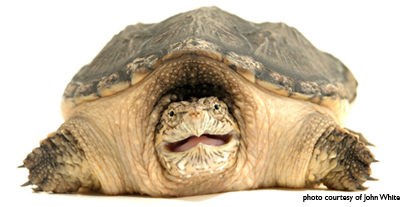 The snapping turtle workgroup was formed and began meeting when the Maryland Department of Natural Resources obtained authority to manage the species with regulations in 2007. This regulatory authority was needed to address high international demand for turtles in an environment that lacked limits on the fishery. The workgroup is composed of scientists, watermen, conservation and pet interests, a seafood dealer, an aquaculturist, a trapper and wildlife control operator and law enforcement. The meetings are co-chaired by Fishing and Boating Services and Wildlife and Heritage Service.
The snapping turtle workgroup was formed and began meeting when the Maryland Department of Natural Resources obtained authority to manage the species with regulations in 2007. This regulatory authority was needed to address high international demand for turtles in an environment that lacked limits on the fishery. The workgroup is composed of scientists, watermen, conservation and pet interests, a seafood dealer, an aquaculturist, a trapper and wildlife control operator and law enforcement. The meetings are co-chaired by Fishing and Boating Services and Wildlife and Heritage Service.
The purpose of the snapping turtle workgroup is to review the status of the resource and to recommend management actions to Fisheries Service for the management of the species for sustainability. Questions about snapping turtle commercial fishing permits and eligibility should be directed to
Casey Marker via email
USFWS Proposes Scrutiny of Snapping Turtle Exports
The U.S. Fish and Wildlife Service has proposed listing the common snapping turtle on CITES Appendix III. To read the press release from U.S. Fish and Wildlife Service, please see:
https://fws.gov/federal-register-file/inclusion-four-native-us-freshwater-turtle-species-appendix-iii-convention
To see what this proposed rule means, please see:
https://www.govinfo.gov/content/pkg/FR-2016-05-24/pdf/2016-11201.pdf
To read the Federal Register notice of intent to amend CITES Appendix III and for directions to provide comments to the U.S. Fish and Wildlife Service by the December 29 deadline, please see:
http://www.gpo.gov/fdsys/pkg/FR-2014-10-30/pdf/2014-25768.pdf
History and Background of the Snapping Turtle Fishery
Snapping turtles have been found in archaeological excavations in the Chesapeake region to at least the Woodland period (1000BC-1600AD). They were used in colonial America as food by settlers and slaves and recorded in the commercial fishery in 1873. The commercial fishery was unmanaged for over 100 years. Snapping turtles were viewed as a nuisance until recently, when their role in the ecosystem as a scavenger and predator has been recognized.
They continue to be blamed for duckling predation, with very little supporting evidence. Increased international demand starting in the late 1990's led the Maryland Department of Natural Resources to seek management authority for this unmanaged species and enabling legislation passed in 2007. A workgroup, representative of all stakeholders and scientific experts in snapping turtles was assembled and first met in 2007. Workgroup members came from turtle harvesters, chosen from their harvest reports, scientists from Towson University and the University of Maryland, National Aquarium in Baltimore, Mid-Atlantic Turtle and Tortoise Society, seafood dealers, an aquaculturist, Nuisance Wildlife Control Operators and Maryland Trappers Association, Conservation International/IUCN, as well as the Maryland Department of Natural Resources (Fishing and Boating Services, Wildlife and Heritage Service, Natural Resources Police).
This workgroup recommended limits to the previously unregulated commercial fishery and to keeping as pets. Further population study was highly recommended to the department. Those recommendations resulted in emergency interim regulations in 2008. Based upon a snapping turtle study by Pat Cain and Rich Seigel of Towson University, in cooperation with waterman John Edwards, data were presented and discussed by the workgroup in 2008. Those data were used to develop 3 management options to present to the workgroup. The recommendations for the regulations in place today were agreed upon by all stakeholders at the last meeting in November 2008 and became permanent starting in 2009. The commercial industry and scientists agreed that these recommendations were the best option for maintaining sustainability.
The 11" minimum CCL possession limit was crucial because it protected over 60% of females. This regulation prohibits possession of turtles under 11" in MD even if they were legally harvested in another state. In addition to the minimum size limit, turtles may only be legally harvested in tidal waters, harvest reports are required, and gear restrictions and float requirements are in effect. Personal use and pet regulations limit possession to one turtle and gear restrictions apply. There is an assumption that non-tidal waters are sanctuaries in effect and that movement may occur between non-tidal and tidal waters.